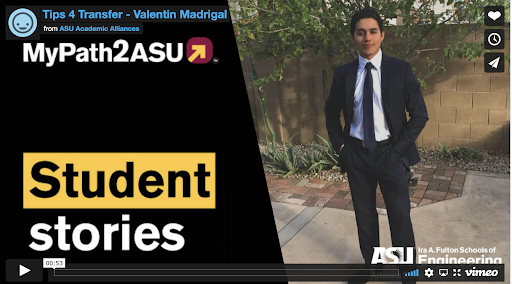Valentin Madrigal is an Arizona State University transfer student from Central Arizona College. Inspired to pursue higher education to support his family, in addition to his fascination with space travel, he chose ASU for its renowned aerospace engineering program and anticipates that he will graduate in spring 2024.
As a first-generation college student, Madrigal chose to begin at a community college, as he struggled through high school and had very little knowledge of the American educational system. Coming from an underdeveloped part of Mexico that lacked a public education system, his parents had difficulties guiding him on his educational journey. He admits to having been an unmotivated student in high school because of impoverishment and family circumstances.
Convinced that he would never be able to go to college with his low GPA and ACT score, Madrigal joined the U.S. Army instead. With hard work and dedication, Madrigal is now a Phi Theta Kappa honor student who was able to fund his education using the GI Bill.
He took advantage of MyPath2ASU, a set of customized tools to help create a seamless transfer experience to ASU after a student earns credits or an associate degree from a U.S. community college or university. It allows students to choose from more than 400 pathways into an on-ground or online ASU degree program and have access to personalized benefits that help them navigate the transfer experience. By taking classes that transfer to ASU, students shorten their time to degree completion.
We talked with Madrigal about his motivations for continuing his education and transfer experience to ASU.
Question: What inspired you to pursue higher education?
Answer: My inspiration for pursuing higher education was to be able to help support my family and my fascination with space travel.
Q: Were you involved in any clubs or organizations at Central Arizona College?
A: Yes. I am a part of Phi Theta Kappa honor society, the upcoming Math Honor society, and the NASA ASCEND space grant program. My participation in these organizations has helped me become more involved in extracurricular activities, aiding my community and personal enlightenment.
Q: Why did you choose aerospace engineering as your major?
A: I chose my major last semester. I really enjoy sciences and math, and I am very interested in space travel and space in general. That's what motivated me to go into aerospace engineering. I was also told that it was a hard major, which motivates me because I love a challenge.
Q: Why did you choose ASU?
A: I chose ASU because it's very close to where I live currently and because I've heard very good things about the Ira A. Fulton Schools of Engineering.
Q: How did the MyPath2ASU pathway program help you?
A: It helped me get a good look at what the future held for me as far as my classes and career. It also helped me pick which classes to take that could transfer.
Q: What have you enjoyed most about your ASU experience so far?
A: I am not taking classes until fall 2021, but I have really appreciated the advising so far. My current adviser has been really helpful in guiding me toward the right direction.
Q: What is one piece of advice you would give to transfer students?
A: To make sure that all the classes that are being taken at the current college are transferrable and apply towards the degree that is being pursued.
Q: What are your plans after you graduate with your bachelor's degree?
A: My plan is to work in the field of aerospace engineering and in the future pursue a master's at Embry-Riddle in aerospace engineering.
More Science and technology

ASU postdoctoral researcher leads initiative to support graduate student mental health
Olivia Davis had firsthand experience with anxiety and OCD before she entered grad school. Then, during the pandemic and as a…

ASU graduate student researching interplay between family dynamics, ADHD
The symptoms of attention deficit hyperactivity disorder (ADHD) — which include daydreaming, making careless mistakes or taking…

Will this antibiotic work? ASU scientists develop rapid bacterial tests
Bacteria multiply at an astonishing rate, sometimes doubling in number in under four minutes. Imagine a doctor faced with a…

